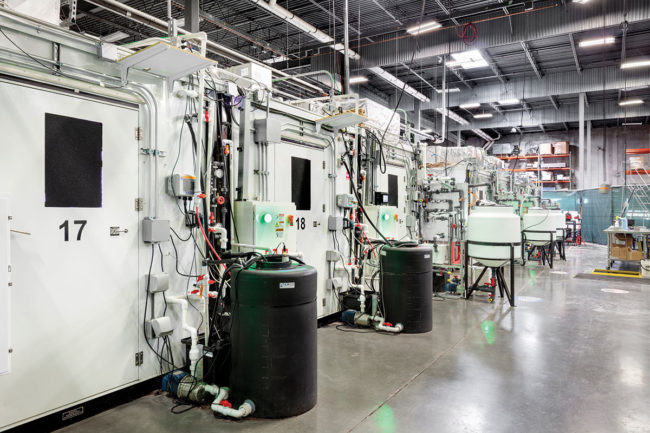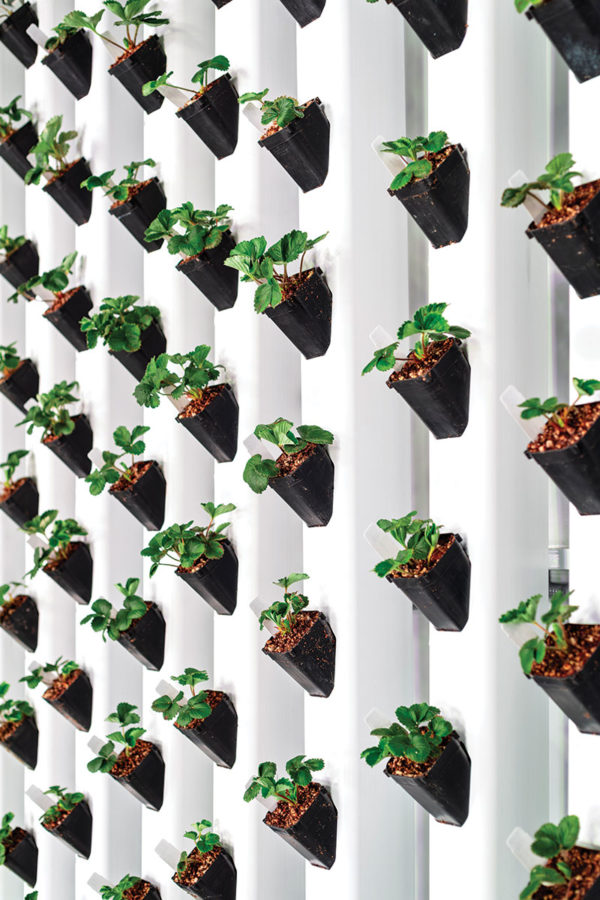Indoor Berries
Driscoll’s, in partnership with Plenty Unlimited, is planning an indoor growing facility designed to marry strawberry growing expertise with vertical farm technology.
Watsonville, California-based Driscoll’s — whose clamshelled berries have become staples in produce departments around the country — hasn’t chosen a site yet or released construction details for the research and development project, said Soren Bjorn, president of Driscoll’s of the Americas, a business division of Driscoll’s.
“Our motivation for indoor farming is how far you can push flavor,” Bjorn said. “We know how good all the flavors can be across all four berries,” referring to strawberries, blueberries, raspberries and blackberries.
Because of strawberries’ compact nature, a grower can place many of the plants on a vertical plane. This leads to better fruit growth afforded by the three-dimension greenhouses, Bjorn said. Though dwarf varieties developed over time could work indoors, the different physical structures of blueberries, blackberries and raspberries wouldn’t work as well because pickers wouldn’t want to bend so much during harvest, he said.
Farming vertically in the cube is different from field farming. Indoor growing requires heating and providing artificial lighting to all the different levels in linear feet as opposed to acres and drives a growers’ costs.

Sea change
“From our perspective, it’s a big change in mindsets because we’re coming from this outdoor environment that’s two dimensional on an acre, or sometimes linear and one dimensional,” Bjorn said. “Because we can go up high (indoors), per-acre productivity must go way up. It’s about what kind of productivity we can get out of every single plant and how we can best use the whole tube.”
With field-grown strawberries, breeders are confident the berry will succeed because they know how it will be farmed and other factors during the seven-year development phase, he said. Developing varieties for indoor production is an entirely different world, Bjorn said.
With environmental factors including rain, heat and pests easier to control indoors, more effort can be focused on flavor. Of the more than 100,000 unique strawberry varieties Driscoll’s produces a year in California, Florida, Mexico and Europe, only one or two may become commercially successful due to disease or productivity performance.
Breeding can also focus on berries that deal well with climate change. Second only to winegrapes, strawberries are sensitive to changes in microclimates. A small shift in a microclimate can suddenly move one winegrape or strawberry variety from being incredible to being just average.
It doesn’t take much — a fog shifting several miles from Monterey Bay to the Salinas Valley can change the quality of what can be marketed as a Driscoll’s strawberry, Bjorn said.
New frontier
The appearance, texture and size of a strawberry grown vertically indoors isn’t expected to significantly vary from its counterpart grown in a field, he said. Driscoll’s wants to grow varieties that are naturally sweeter and offer more consistent delivery.
“Indoors, a variety can consistently deliver what you communicate about its sweetness,” he said. “It takes away those ups and downs that naturally happen outside.”
In its infancy, technology for growing berries indoors is expensive and often custom-made, Bjorn said. The work Driscoll’s has done with Plenty and its indoor farming technology has been successful and produced high-quality berries, he said. In October 2020, Plenty announced a round of investments from companies that included Driscoll’s, kicking off a partnership to grow strawberries year-round indoors.
“We had to learn a little from our friends in Silicon Valley,” Bjorn said. “You’re on a technology curve that’s not on a straight line. It’s growing exponentially over time.”
In outdoor growing, a step change could be growing raspberries in plastic tunnels. Compare that to continuous exponential improvements seen via technologies coming out of tech centers around the world, Bjorn said.
“We have had a lot to learn to get into that world,” he said. “It’s healthy because it’s made us think differently about the rest of our business.
Organics aren’t being considered initially because Driscoll’s plans to market indoor berries differently and promote elements of sustainability more so than organic growing methods.

While Driscoll’s grows some fruit, it relies on 900 independent growers. Driscoll’s growers range in size from five acres to others harvesting several thousand acres. Unlike the meat industry, where four packers control most of the distribution and producers’ pay isn’t tied as much to market conditions, Driscoll’s keeps its growers updated weekly on changing economics and bases growers’ returns on market demand.
Planting an acre of strawberries in California could cost $35,000. With harvest costs adding another $35,000-$40,000 an acre, a grower could easily invest $80,000 on one acre.
“Berry growing is very high-touch and requires a lot of attention, compared to other growing, especially strawberries and raspberries,” Bjorn said. “A grower could lose a strawberry field in two days. They just can’t plant the berries, go golfing or go on vacation and come back.”
Viewing vertical farming as complementary to conventional growing methods, Bjorn doesn’t envision indoor berries ever replacing field-grown.
“It’s kind of like organics, which became more complementary in nature to our commercial strawberry production,” he said. “It can attract a new group of consumers.”










